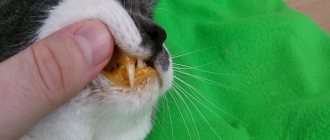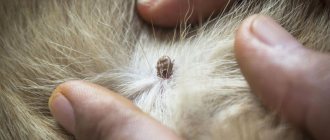What is cheyletiellosis
The disease affects various types of animals:
- cats;
- dogs;
- hamsters;
- guinea pigs.
Cheyletiellosis is characterized by rapid transmission from sick individuals to healthy ones. The disease is caused by the tick Cheyletiella blakei, which can be examined in detail under a microscope.
The dimensions of the parasite are from 0.25 to 5 mm. Its body is colored yellowish and has an oval shape. The pathogen has a powerful mouth, and successfully stays on the body of the “host”.
The main habitat of the tick is the keratin layer of the animal's skin. The parasite does not penetrate deep into the epidermis. Favorite areas of the body are the back, neck, groin, and the area behind the ears. Sometimes Cheyletiella blakei is found in the nostrils.
Parasites regularly lay eggs attached to the hairs. Hatched larvae go through a development cycle in 1-1.5 months, then become sexually mature individuals.
Signs of cheyletiosis
The tick, with the help of microscopic and sharp jaws (chelicerae), pierces the epidermis, stimulates the flow of skin lymph and tissue fluid. Due to the fact that the integument is irritated and not destroyed, the first signs are:
- Anxiety;
- Itching in the neck and head and back of the body;
- Small gray or white scales – dandruff in areas of parasitism;
- Split hair and hair loss;
- Baldness (alopecia) of areas of reddened (hyperemic) skin;
- Downy rabbits have matted fur.
Photo. White or gray dandruff due to cheyletiosis
Stray dandruff is the main sign of cheyletiosis in rabbits
How does the disease progress in cats?
In most pets, feline cheyletiellosis provokes moderately severe symptoms. Often the manifestations of the disease resemble allergies.
Adult animals have good tolerance to pathology. Often in these cats the disease goes away without obvious signs and does not cause a significant deterioration in health.
It is important to know! Kittens under 6 months of age and older pets react most severely to the disease.
The pathology is considered dangerous even if it is asymptomatic. The infection tends to instantly spread to others (both animals and people). The disease spreads especially quickly in the absence of high-quality conditions for keeping cats, or in the absence of several pets living in the house at once.
Veterinarians warn that it is better to refuse independent attempts to cure a cat. Such actions often end in failure and can cause further harm. If the first symptoms of feline cheyletiellosis appear, you should immediately visit a doctor.
Danger to humans
In some cases, the disease can affect owners of infected pets. Infection of owners occurs quite often - in 30% of cases.
The parasite settles on the human body temporarily, but manages to cause unpleasant symptoms:
- itchy rash;
- small erythematous papules on the trunk and arms.
It is possible to completely get rid of the disease and protect all inhabitants of the house from the risk of infection with the Cheyletiella blakei mite only after the pet has fully recovered.
Symptoms: how does cheyletiellosis manifest?
A clear clinical picture is observed in young and elderly cats whose immune systems are still immature or already weakened. The development of ticks is also facilitated by decreased immunity due to severe infectious diseases. In long-haired cats, there are almost no signs of the disease. Symptoms:
- symmetrical hair loss;
- licking and biting fur by a cat;
- itching - mild or severe;
- the appearance of dry pimples on the affected areas of the skin;
- peeling of the dermis and the formation of large dry dandruff;
- disheveled, dull coat;
- increased secretion of sebum.
Return to contents
How does infection occur?
The cause of infection with harmful mites is most often direct contact with a sick cat. Also, Cheyletiella blakei infection occurs as a result of touching the things of an infected animal.
In addition to contact, a cat can contract an infection after drinking contaminated water or poorly processed meat. Some pets become infected with ticks from flies, fleas, and lice that carry this parasite.
In more rare cases, infection results from living in apartments or houses where carriers of the disease were previously present. Sexually mature individuals of Cheyletiella blakei have the ability to exist for some time outside the body of the “host” (this period is measured in 2-10 days). If a suitable “candidate” appears within the tick’s reach, it cannot avoid an instant attack from the hungry parasite.
Causes
Cheyletiosis is transmitted from individual to individual. Most often, it develops in conditions with insufficient compliance with sanitary standards and a large concentration of animals: nurseries, pet stores, animal shelters, etc.
A healthy dog can become infected after contact with an affected dog. A dog can become infected by lying on the bedding of a sick animal or by being in the same room with it. This disease does not select the breed or age of the animal, however, it is most often found in puppies under 8 weeks of age. Once on the body of a new host, adult females begin to intensively lay eggs. The development of an individual lasts 3-5 weeks, and an adult cheyletiela lives for about two weeks.
Cheylethiosis has become widespread throughout the globe as a result of the significant increase in travel. Dogs can travel with their owners by any means of transport. At the same time, other animals in different countries and even on different continents become susceptible to the disease.
Symptoms of the disease
Symptoms of cheyletiellosis can appear in cats within a short period of time after infection. The disease is accompanied by:
- peeling of the skin, the formation of ulcers, papules, and areas with erosions;
- hyperpigmentation of the epidermis;
- skin itching;
- hair loss, fraught with partial or complete baldness;
- loss of appetite;
- apathy;
- insomnia.
As the disease progresses, body temperature may rise. Sometimes disorders of the digestive system develop and allergic reactions occur.
This pathology is characterized by movement of areas of the epidermis susceptible to damage. Due to this feature, cheyletiellosis is also called “stray dandruff”.
To reduce the itching sensation, sick animals itch vigorously and scratch their skin until blood appears. Many pets acquire a sloppy appearance, become disheveled and restless.
Cheyletiellosis not only causes discomfort and deterioration in the appearance of the cat. Pathology can significantly weaken the animal’s immune system, making it defenseless against viral and bacterial infections.
Basic information about the pathogen
The Cheyletiella mite is a highly contagious, zoonotic skin parasite that feeds on the keratin layer of the skin. This parasitic skin disease is similar to a flea infestation and is treated with the same medications and methods used to kill small blood-sucking parasites. The prevalence varies by geographic latitude, but in recent years this infection has become increasingly common. These mites primarily infect cats and dogs, but the parasite can also live on human skin for some time.
This disease is called “stray dandruff” in some sources. The pathology received this name because of the way the parasite moves through the keratin of the skin. When viewed from above, the hide resembles a road-riddled surface, marked by raised and flaky skin flakes. Mites usually cause mild irritation, but in young cats the infestation can be much more severe. The fact is that in young animals the immune system has not yet fully formed, and therefore their risk of developing secondary infections sharply increases. However, the same applies to old cats.
Diagnosis of cheyletiellosis in cats
The first stage of examining your pet is a general clinical examination, which allows you to immediately identify the largest parasites. To obtain complete information about the course of the disease, laboratory procedures are necessary.
Diagnostics continues using the following methods:
- examination of combed wool, which makes it possible to detect adult individuals and the eggs they have laid;
- scraping or tape test, which helps identify dead scales of the epidermis;
- trichogram, which specifies the degree of hair loss.
Cats often swallow ticks by licking their lips. For this reason, many veterinarians additionally order a stool test.
Differential diagnosis makes it possible to distinguish cheyletiellosis from diseases with similar manifestations. Special procedures help to detect the difference between this pathology and demodicosis, sarcoptic mange, seborrhea, and dermatophytosis.
Diagnostic methods
Although Cheyletiella mites can sometimes be seen moving around on the skin (they are far from small), in many cases they can be quite difficult to find. Skin scrapings or dandruff samples (especially if pathological material is collected with tape or a fine-tooth comb) should be analyzed microscopically to identify adult parasites and their eggs. Their eggs are also often found in fecal samples, as dogs constantly ingest them by licking the skin. However, none of these methods are foolproof, and ticks cannot be "caught" for sure even when they are present (especially in cats).
Therefore, a preliminary diagnosis can be made based on signs and symptoms, which are often quite specific. By the way, drug diagnostics are often used by Western specialists, since at the same time it allows us to exclude flea dermatitis and some other diseases of tick-borne etiology.
Treatment of feline cheyletiellosis
Treatment measures must be carried out without delay, immediately after confirmation of the diagnosis. The basis of therapy is the use of antiparasitic agents applied to the skin of the cat. In order to ensure complete treatment of problem areas, long hair is trimmed.
Owners of sick cats need to remember the following:
- if there are several pets in the house, they all must undergo treatment (otherwise the disease will quickly spread to healthy individuals);
- while carrying out therapy, you need to simultaneously monitor the cleanliness of the house, sanitize cat bedding, accessories, dishes, and treat upholstered furniture (using chlorine-containing products);
- it is important to regularly bathe a sick pet, thus speeding up the cleansing of the skin from parasites;
- Medications should be applied only after water procedures.
The causative agent of the disease is characterized by high vitality. To clean the animal’s skin and the entire room from ticks, you must strictly follow all the instructions of your doctor.
Essential Medicines
Treatment for cheyletiellosis in cats takes 6 to 8 weeks. Special veterinary preparations are used to treat the pet’s skin.
The following topical medications help defeat the parasite:
- Butox;
- Demos;
- Acaromectin;
- Ivermec spray;
- Leopard.
Such medications are used 2-3 times in a row. Next, a break of up to 2 weeks is required. For faster restoration of damaged skin and coat, cats are additionally recommended vitamin and mineral complexes with biotin.
The main course is often supplemented by the administration of Ivermectin tablets taken orally. In difficult cases, injections with Ivermek are necessary.
It is prohibited to give injections yourself for cheyletiellosis in cats. Such procedures can only be performed as prescribed by a veterinarian. .
Leporacrus - fur mite on rabbits
The manifestation of parasitism of the heylet is reminiscent of parasitism of the lepocarus mite. The causative agent Leporacarus gibbus is an opportunistic parasite that feeds on the secretions of the sebaceous glands. Scratching on the skin of rabbits with lepocarus looks different than with cheyletiosis:
- It is not the neck, head and back that are affected, but the lower abdomen and back of the body;
- Dandruff (seborrhea) is not typical for the Lepocarus fur mite.
The rest is very similar - these are alopecia and itchy skin. In severe form, weeping dermatitis.
The fur mite - leporacrus - often manifests itself asymptomatically
The Leporacarus gibbus tick can accidentally enter the territory of our country with animals infected with it when moving across the border. Treating rabbits affected by fur mites is not difficult. Typically, ivermectin is administered subcutaneously, or the hair is treated with pyrethroids (neostomozan).
Prevention of feline cheyletiellosis
Primary prevention of cheyletiellosis in cats is ensured by regular washing of the pet, keeping the animal, its accessories, dishes, toys, etc. completely clean. An important role in the prevention of parasitic infection is played by a balanced diet, fortification, carried out several times throughout the year, and the exclusion of contacts with unclean stray animals.
After an illness, it is important to take all measures to prevent its recurrence. It is necessary to carry out frequent cleaning of the premises, using insecticides and preparations containing chlorine. To exclude recurrent cheyletiellosis in cats, it is necessary to treat the animal’s bedding with acaricidal agents (3-4 procedures are sufficient, with 5-day intervals between them).
Our materials will be useful for you and other users. Share the article on social networks! Click!
Cheyletiellosis: what it is and modes of transmission
Obvious signs of cheyletiellosis are bald spots on the ears, neck, back, hairs do not hold well and fall out. The dog is constantly bothered by places where ticks accumulate; it scratches the affected areas vigorously, causing wounds, pustules and an inflammatory process.
The disease is also called “wandering dandruff”, since many scales and crusts form at the site of mite penetration. Skin changes pigmentation. Another name is “body louse.”
The disease is highly contagious, which means that contact cheyletiellosis spreads rapidly, especially in places where there are large concentrations of dogs and violations of the rules of hygiene and their maintenance. Theoretically, the tick is transmitted to humans, but according to statistics, in no more than 30% of cases, and it is necessary for the owner (care staff) to have long and close contact with the sick animal without protective equipment.











